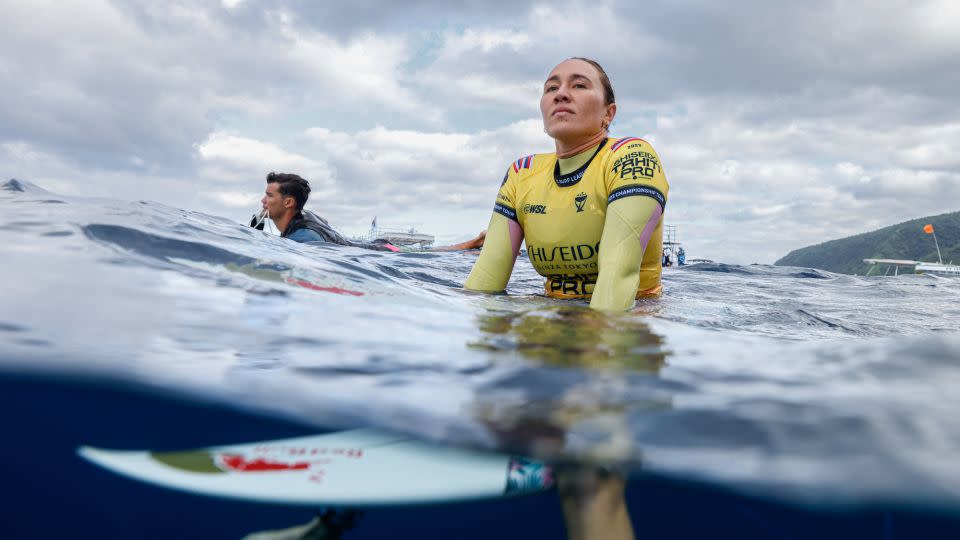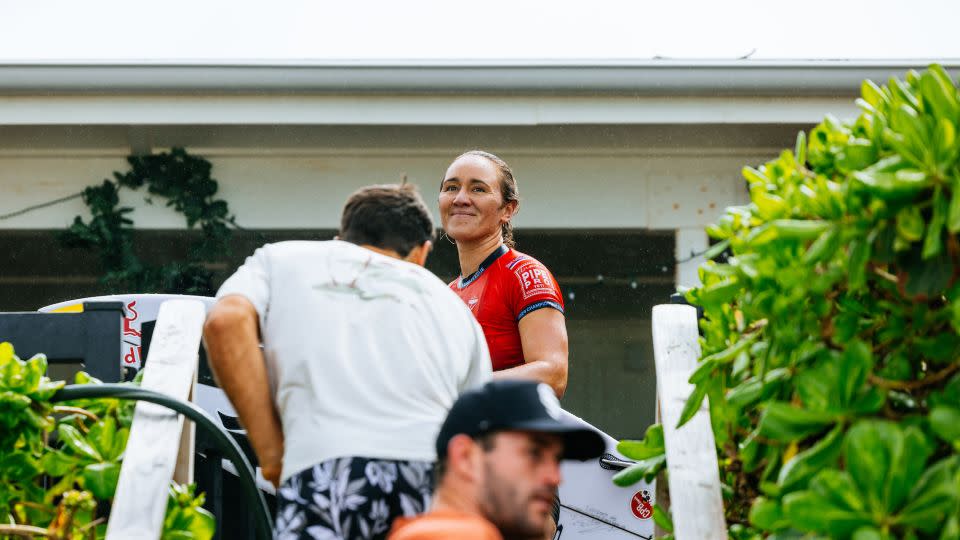Before stepping away from surfing, Olympic champion Carissa Moore has a showdown with ‘big, intense, scary’ Teahupo’o
Carissa Moore remembers the first time she surfed Teahupo’o, the barreling wave located off the island of Tahiti.
A recent high school graduate, Moore was short on experience – without the world and Olympic titles she possesses today – but high on curiosity and adrenaline. It didn’t take long, however, for Teahupo’o to live up to its reputation as one of the most fearsome waves on the planet.
“I was so out of my league,” recalls Moore, who has surfed the famous break numerous times throughout her career. “I had never surfed a wave like that ever in my life and was scared out of my pants.”
Teahupo’o seems like a postcard from French Polynesia, a picture-perfect barrel cocooning surfers as they slice neatly across its face, a mass of foamy swell collapsing behind them. But in the wave’s beauty lies also its danger: anyone who surfs Teahupo’o risks being swallowed up by its steep, thundering wall of water and dragged onto the shallow reef below.
“It’s those waves that scare you the most that end up being the best,” Moore tells CNN Sport. “It’s this weird thing – your body and your mind are telling you no, but then you have to tell yourself that these [waves] are good, you have to go.
“It’s not a natural thing. The consequences are huge. I mean, if you fall, you could get really hurt. People have had some really horrible wipeouts and injuries from that wave. You have to tell yourself, ‘Hey, I could also get the ride of my life and the thrill of my life at the same time.’”
Teahupo’o, often referred to as “The End of the Road,” will play host to this year’s Olympic surfing event, as well as this week’s Tahiti Pro where Moore has been granted a wild card entry as she steps up her preparation for Paris 2024.
The Hawaii native is at an important juncture in her career. She announced at the start of the year that she would be stepping away from competitions, appearing only at the Tahiti Pro and the Olympics.
Moore insists that she is not retiring, instead referring to this period as “a shift and an evolution.” That means embracing pursuits away from the water – devoting time to her foundation, releasing a book, and finalizing a film with Red Bull about her life and career.
This week, though, the focus is back on surfing. Unlike her rivals, Moore may not possess the sharpness that comes from having competed at multiple events already this season, but it’s hard to see the five-time world champion losing her competitive edge during her brief time away from the tour.
She was also able to take a training trip to Tahiti several weeks ago, a timely reminder of Teahupo’o’s violence and power.

“The waves are big and intense and scary … I don’t really feel like you can ever get totally 100% comfortable at a wave like Teahupo’o, but I believe that the more that you put yourself in uncomfortable situations, the more comfortable you will get,” says Moore.
“That’s kind of how I’ve always worked. I’m a very calculated risk-taker. The more time that I get out there, the better I’ll feel. And I think when that opportunity comes in a heat, I’ll know that I can go.”
Surfing made its Olympic debut in Japan three years ago, meaning Moore is the sport’s first and only female gold medalist. She will, of course, want to defend her title and begin her indefinite period away from competitions on a high.
“I’m so grateful I even won one gold medal,” says the 31-year-old. “In surfing, just to have it all come together in one event with the variables and all of that is super special.
“I know it’s asking a lot from the universe for it to have it happen again, but I believe I’m going to give it my best shot. I don’t know if there’s this huge pressure on myself to win gold … because sometimes that kind of pressure hinders performance.”
Environmental concerns about the staging of the Olympics in Tahiti, almost 10,000 miles from the host city of Paris, have already threatened to overshadow the event.
The shallow coral reef, which helps to generate the heaviest, thickest wave in the world, was damaged by a barge last year during the construction of a nine-ton aluminum tower – something organizers said was necessary to host the 40 people involved in judging and televising the competition.
That prompted outcry from the International Surf Association, as well as other members of the surf community; for World Surf League (WSL) events in Tahiti, a wooden structure is usually erected and later removed.
“Hearing about how it was navigated could maybe have been done with more love,” says Moore. “I am a huge advocate for the environment and the reefs and the oceans – that’s our playground – and I know that we have to do our very best to preserve it moving forward.
“There’s not much we can do now, but I definitely want to find a way to impact the community in a positive way and leave something for the next generation.”

One idea she talks about is the possibility of securing land to create a soccer field for kids living in the village of around 1,500 people, which she says is in “the brainstorming stages” right now.
Inspiring the next generation is a subject close to Moore’s heart. Her foundation, Moore Aloha, was formed at a time when she was struggling mentally with life on tour, lacking a sense of purpose and passion. It uses surfing as a platform to empower young girls as they “navigate the waves of mental health, wellness and womanhood.”
“Growing up as a young woman, I realized there weren’t as many opportunities for girls, especially in the ocean,” says Moore. “It started off just as surf mentorship and sharing the aloha spirit, and it still is that … getting out and doing something creative is so positive and powerful for the mind.
“There has been an increase in depression and anxiety and different stresses we have, and being in the ocean, you don’t catch your phone. It’s that one time of the day for myself, even, that the rest of the world disappears and I’m present. And I think by being present, we can really get to know ourselves.”
Knowing herself and what she wants from life has been central to Moore’s decision to step away from surfing, an announcement which had been a year in the making.
She has previously discussed the possibility of starting a family, though her future, both in and away from the ocean, remains unclear. For one of the greatest surfers of all time, the luxury lies in being able to carve her own path.
“I’m not closing the door completely on the tour and competing, but I definitely want to give myself the space and grace to figure out what’s next,” says Moore. “Maybe I return, maybe I just focus on Moore Aloha and free surfing and doing film projects. Who knows?”
For more CNN news and newsletters create an account at CNN.com

 Yahoo Sport
Yahoo Sport 






































